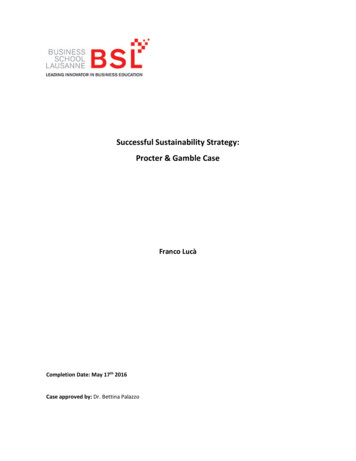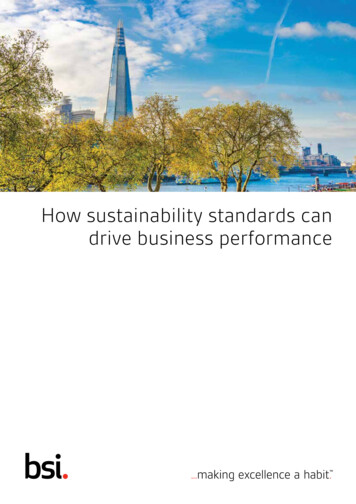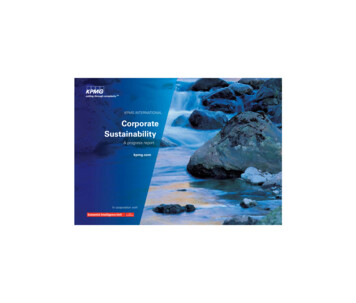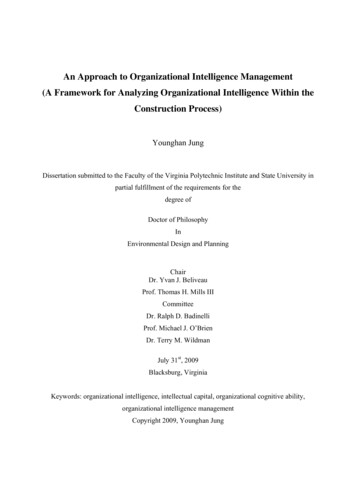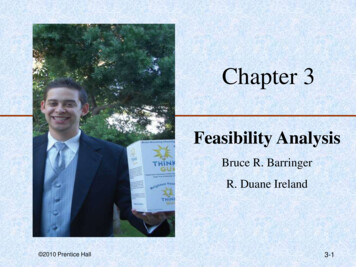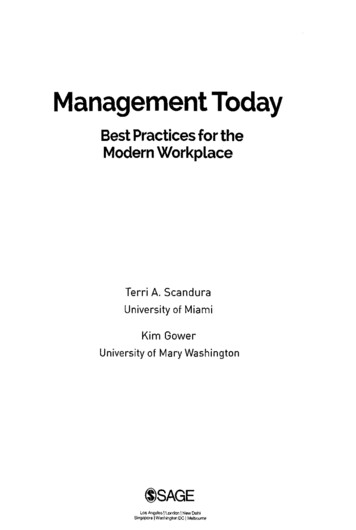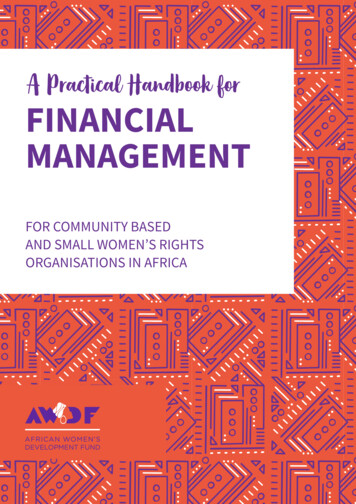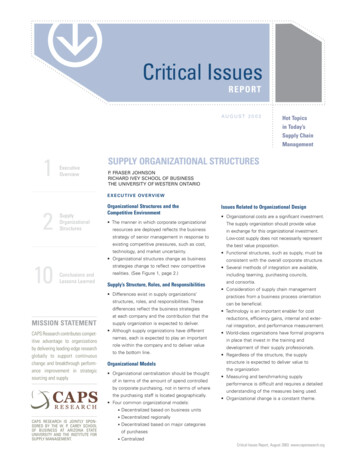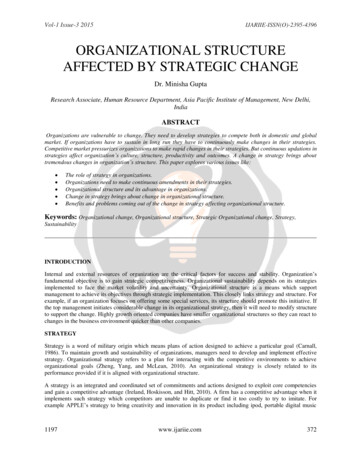
Transcription
MANAGINGORGANIZATIONALSUSTAINABILITY:THE BUSINESS CASE FOR SUSTAINABILITYPROFESSIONALS IN THE WORKPLACEJULIA RUEDIGMasters CandidateUniversity of Michigan Erb Institute of Global Sustainable EnterpriseANISA BALDWIN METZGER, Assoc. AIA, LEED AP BD C O MThe Center for Green Schools at the U.S. Green Building Council
MANAGINGORGANIZATIONALSUSTAINABILITY:THE BUSINESS CASE FOR SUSTAINABILITYPROFESSIONALS IN THE WORKPLACEJULIA RUEDIGMasters CandidateUniversity of Michigan Erb Institute of Global Sustainable EnterpriseANISA BALDWIN METZGER, Assoc. AIA, LEED AP BD C O MThe Center for Green Schools at the U.S. Green Building CouncilCopyright 2013 by the U.S. Green Building Council, Inc. All rights reserved.
TABLE OF CONTENTSEXECUTIVE SUMMARY . 1THE STATE OF SUSTAINABILITY PROGRAMS IN ORGANIZATIONS:Background and Basis for Analysis . 2HOW ARE THE ROLES OF DEDICATED SUSTAINABILITY STAFF DEFINED? . 5HOW IS SUSTAINABILITY PERFORMANCE EVALUATED? . 9HOW DO DEDICATED SUSTAINABILITY STAFF CONTRIBUTE TOTHE SUSTAINABILITY PERFORMANCE OF THEIR ORGANIZATIONS? . 13CONCLUSION: TYING IT ALL TOGETHER . 15FUTURE RESEARCH . 16APPENDIX A:Insignificant Correlation Coefficients for Selected UC Sustainability Metrics . 19APPENDIX B:Significant Correlation Coefficients in Selected UC Sustainability Metrics . 19WORKS CITED . 20
EXECUTIVE SUMMARYThe growing presence of sustainability programs in public and privateorganizations has created new staff positions for individuals who canmanage, coordinate, communicate and measure sustainability-relatedinitiatives. According to the U.S. Bureau of Labor Statistics, the numberof people employed in Green Goods and Services increased just overfive percent in one year (US Department of Labor, 2013). The number ofinstitutions that are members of the Association for the Advancementof Sustainability in Higher Education (AASHE) has increased 37percent in the last four years (AASHE, 2012; AASHE, 2009). And theAssociation of Climate Change Officers (ACCO), which began in 2009with 14 member organizations, now counts more than 100 participatingorganizations (ACCO, 2013).Sustainability staff arecoordinators, convenersand communicators forsustainability-relatedactivity across functions anddepartments. They rely on manycolleagues to both implementand measure progress relatedto sustainability, creatingan indirect route to metricsthat indicate sustainabilityDespite this rapid growth, a 2011 study by the Weinreb Group foundperformance.that the field still has much room to grow. In their survey, 29 companiesamong the roughly 7,000 publicly traded companies in the U.S. haveestablished Chief Sustainability Officers since the first was appointed in2004 (Weinreb Group, 2011). With the discipline of sustainability management advancing quickly to step into newtop-tier leadership roles, pressing questions remain. How can dedicated sustainability staff support the goals of theirorganizations by improving sustainability? And how can they demonstrate that they have done so?Current research makes clear that consensus has yet to be reached as to how sustainability staff should approachtheir work and evaluate their progress. Because true sustainability strategy reflects the business aims of itsorganization, sustainability officers take on unique roles, responsibilities and functions. Sustainability staff arecoordinators, conveners and communicators for sustainability-related activity across functions and departments.They rely on many colleagues to both implement and measure progress related to sustainability, creating an indirectroute to metrics that indicate sustainability performance. Research that captures how a sustainability practitionerinfluences the sustainability performance of his or her organization is just beginning to emerge from the fields oforganizational studies and management performance.By connecting managerial competencies to organizational structures and ultimately to sustainability performance,researchers are beginning to gain greater knowledge of just how sustainability managers can measure successes andlink them to an organization’s overall goals. This paper focuses on qualitative research, both original and existing, thatexplores the core functions sustainability staff perform and how their role relates to improving both sustainability andother key organizational objectives.THE CENTER FOR GREEN SCHOOLS AT USGBC1
THE STATE OF SUSTAINABILITYPROGRAMS IN ORGANIZATIONS:BACKGROUND AND BASISFOR ANALYSISSince Milton Friedman uttered his infamous creed, “the socialresponsibility of business is to increase its profits,” (Friedman, 1970)much has changed in the landscape of business and in our publicinstitutions. The scope of business as usual has been broadened toincorporate the impacts of business as usual on the systems thatsurround and support organizations. According to a global survey byKPMG in 2010: “62 percent of companies surveyed now have a corporatesustainability strategy, up from just over half in February 2008 Just5 percent have no plans to create such a strategy, while the remainingfirms are in the process of developing such a plan” (KPMG, 2011 [13]).62 percent of companiessurveyed now have a corporatesustainability strategy, upfrom just over half in February2008 Just 5 percent have noplans to create such a strategy,while the remaining firms are inthe process of developing sucha plan (KPMG, 2011 [13]).Beyond sustainability engagement in corporations, educationalinstitutions in the U.S. are also increasingly engaged in sustainability. TheAssociation for the Advancement for Sustainability in Higher Education, a non-profit that provides sustainabilityresources to higher education institutions, has seen a steady increase of membership, even through the tougheconomic climate of the past few years (Flint-Chatto, 2011 [15]). It is clear that organizations are increasinglyreaching a tipping point at which they decide to incorporate sustainability into their structures. However, this tippingpoint looks different for each organization, depending on their unique strategies and existing structures.A subset of organizations deeply incorporates sustainability in thecompany’s mission or core values. Organizations such as Patagonia,Method or Green Mountain College embody a niche of organizationswhose core values and daily operations are infused with the principlesof environmentalism, stewardship and sustainable development. Thesesustainability leaders set ambitious goals such as carbon neutralityand lead sustainability innovation in their respective fields. While suchorganizations are inspirational and influential beacons, they are not thenorm.One academic case showsthat environmental legislationand consumer concernfor environmental issuesinfluence corporate action, andadditionally corporate actioncan also influence stakeholders’behavior (Pizolatto andMost organizations are reacting to either direct or indirect pressures toZeringue, 1993).incorporate sustainability into their organizational architecture. Indirectpressure may come from the desire to avoid the label of ‘laggard’ ascompetitors or peer organizations adopt sustainability programs. Directpressure may come from suppliers, buyers, shareholders, consumers, social activists, investors, insurers, tradeassociations, academic institutions, religious institutions or regulators (Hoffman 2001).2MANAGING ORGANIZATIONAL SUSTAINABILITY
The catalyzing effect of stakeholder pressure is supported by a well-developed field of study, with many empiricallydocumented cases (Delmas and Toffel, 2010; Hoffman, 2001 [142]). One academic case shows that environmentallegislation and consumer concern for environmental issues influence corporate action, and additionally corporateaction can also influence stakeholders’ behavior (Pizolatto and Zeringue, 1993). Original research conducted for thisstudy found supporting evidence for this phenomenon from one corporate sustainability director of a major financialsector company. His company’s sustainability program was founded after shareholders began the shareholderresolution process to demand that the company begin reporting on key sustainability metrics. While a shareholderresolution never came to fruition, the company reacted by forming a sustainability program that incorporatedshareholder requests, leading sustainability practices for the industry and sustainability objectives from companyleadership. Thus, the company’s sustainability program was determined through a blend of outside pressure forsustainability measurement, internal goals and leading industry practices.Existing internal structures are a powerful influence, as they may predetermine how a sustainability program canfunction (Smith, 2011). For example, a sustainability program operating in an organization that places heavy emphasison quarterly performance may not have an opportunity to pursue long-term investment opportunities. However,a sustainability program operating in an organization that values long-term strategy would have an opportunityto pursue both long-term and short-term initiatives. Accounting structures are just one example of how existingstructures may influence the form of a sustainability program. Other internal factors include governance, culture,leadership, business plan, measurement and reporting, organizational learning capacity and information systems(Delmas and Toffel, 2010; Smith, 2011 [75-80]).Once an organization decides to initiate a sustainability program, the organization then structures and staffs theprogram, taking the program’s form and goals into consideration. Currently, there is little academic literature onorganizational architecture that is specific to sustainability programs and sustainability staff. Sustainability programsand sustainability staff are increasing at such a rate that academic research on the subject is still emerging, leavinggaps in knowledge. The specific relationship between sustainability staffing models and outcomes of sustainabilityprogramming is one such gap. However, untested models hypothesizing the role of sustainability in corporationsare emerging and showing how sustainability staff are key to organizational outcomes. One such model, recentlydeveloped by professor of management Dr. Marc Epstein and illustrated on the following page (see Figure 1),provides a foundation to analyze how sustainability staff provide organizational impacts.Sustainability staff are a key part of Epstein’s model. As an input, sustainability staff are part of a corporation’shuman resources. Epstein says that “organizations need educated and trained individuals throughout theorganization who can be sensitized to sustainability issues along with staff who can be specifically dedicated tosustainability.” The level of committed human resources to sustainability “will significantly impact the ability toimplement sustainability programs.” (Epstein, 2008, [49])According to Figure 1, sustainability staff could be seen as either an “input” (under “human and financial resources”)or a process (under “leadership”). In this model, those “processes” create three impacts: financial costs and benefits,social impacts (including environmental sustainability performance) and long-term financial impact. These specificimpacts are measurable outcomes that demonstrate the level of environmental, social or financial performance,which all contribute to an organization’s sustainability performance.THE CENTER FOR GREEN SCHOOLS AT USGBC3
FIGURE 1: Epstein’s Corporate Sustainability ModelTHREE MAJOR SETS OF IMPACTS1 Corporate Costs/Benefits of Actions2 Social Impact3 Financial Impact through Sustainable ainabilityStrategy2SustainabilityPerformance(may be bothan output ate Costs/Benefits of ActionsHuman andFinancialFeedback LoopSource: Marc J. Epstein, Making Sustainability Work: Best Practices in Managing and Measuring Corporate Social, Environmental, and EconomicImpacts, Greenleaf Publishing Limited, Sheffield, England, and Berrett-Koehler Publishers, Inc., San Francisco, Calif., 2008This report aims to focus at a higher resolution than Epstein’s model by casting a spotlight on the role of thesustainability professional and his or her role in the sustainability performance of organizations. With littleacademic or practitioner research currently available on the topic, this report will provide a preliminary explorationof the relationship between sustainability professional and performance as well as the opportunities, challengesand suggestions for future research. Original interviews of sustainability practitioners in both public and privateorganizations were conducted for this preliminary research. In all, 12 in-depth interviews were conducted withorganizations, including higher education institutions, K12 school districts and corporations from a variety ofindustries.To begin to answer the question of how dedicated sustainability staff contribute to the sustainability performanceof their organizations, we break the question into sub-questions, in order to clarify the nature of the overarchingquestion. First, we will examine how “dedicated sustainability staff” is defined by current practitioners to provide aclearer picture of how role functionality leads to final outcomes.Next, we will examine how sustainability performance is evaluated by current practitioners in order to understandwhich metrics are most common and useful in evaluating success of sustainability performance. The final section,a synthesis of the two just described, will examine the main research question through current academic studies,survey findings and suggestions for future research.4MANAGING ORGANIZATIONAL SUSTAINABILITY
HOW ARE THE ROLES OFDEDICATED SUSTAINABILITY STAFFDEFINED?{What trends are emerging in sustainability staff responsibilities, and how are the rolesdefined within the context of organizations? This section provides an understanding of howsustainability work is being conducted by staff.{The goals and functions of sustainability programs vary from organization to organization because sustainabilityprograms are designed to meet the specific needs of their respective organizations. The roles of dedicatedsustainability staff therefore take many forms across organizations. Further complicating the definition ofsustainability staff is the cross-functional and highly collaborative nature of their roles as compared to individualswhose roles may be defined very similarly. This section will explore sustainability in the organizational chart and whatresponsibilities are filled by sustainability roles.THE NEED FOR SUSTAINABILITY STAFFIn every interview conducted for this study, sustainabilityIn every interview conducted for thisprofessionals said that their role was created after top leadershipstudy, sustainability professionals saidin the organization agreed to initiate, intensify or consolidatesustainability efforts, resulting in the decision to create athat their role was created after topsustainability program. Thus, roles were created after leadershipleadership in the organization agreeddevised a general strategy for incorporating sustainability intoto initiate, intensify or consolidatethe organization, giving rise to the need for a manager to leadsustainability efforts, resulting in theor coordinate new efforts. This phenomenon is corroborated bydecision to create a sustainabilitya recent survey conducted by the Society for Human Resourcesprogram.Management. According to the survey, 36 percent of organizationssurveyed indicated that the senior management team wasresponsible for creating the sustainability strategy, followed by22 percent of organizations whose CEO/President developed the sustainability strategy. Thus, when sustainabilityprofessionals step into these new roles, expectations to meet specific objectives already exist. At the same time,the given roles and responsibilities are not static; all participants agreed that their roles and responsibilities wereconstantly evolving to fit emerging needs of the organization.The most common reason for establishing sustainability programs, as stated in six of 12 interviews, was thatleadership wanted to consolidate various sustainability efforts across the organization by adding unity and structureto existing efforts. Prior to establishing sustainability programs, these professionals stated that sustainabilityefforts were ad hoc projects or that responsibilities were split across several positions. These responsibilities wereinstitutionalized and consolidated once the sustainability program was established and the sustainability-focusedposition was created. Two of the organizations created and staffed sustainability programs to respond to pressuresTHE CENTER FOR GREEN SCHOOLS AT USGBC5
from customers, shareholders or stakeholders. Two of the organizations stated that programs were created when topleadership decided to take action on sustainability, but could not elaborate further why top leadership came to thatconclusion. The remaining two organizations either did not know why the programs were created or stated that theprogram was a blend of external pressure, desire to consolidate and top leadership support.THE ORGANIZATIONAL CHARTGiven the many ways that sustainability programs come to exist in organizations, it is no surprise that sustainabilitystaff occupy diverse locations in the organizational structure. The Association for the Advancement of Sustainabilityin Higher Education (AASHE) captures this in their 2010 annual survey of sustainability professionals working withincollege and university environments:FIGURE 2: Sustainability Office Location, AASHE SurveyFacilities Management149Order of Sustainability100Academic Center or Department58V.P.’s Office (Non-Academic)48Provost / Academic V.P.’s Office28Planning / Capital Projects / Campus Architect28Office of the President23Other100Number of ResponsesTOTAL RESPONDENTS: 432TOTAL RESPONSES: 534FIGURE 3: Positions of Interviewed Sustainability Staff in the Organizational StructureDIVISION OF POSITIONTOP-LEVEL REPORTOperationsChief Sustainability Officer/Chief Procurement Officer (dual role)Human ResourcesVP of Human ResourcesFinanceChief Financial OfficerEnvironment, Health, & SafetyChief Operating OfficerNorth American Sustainability OfficeChief Sustainability OfficerGlobal Supply ChainVP Environment, Health, & Safety and Product SustainabilityFacilitiesEnvironmental Services ManagerOperationsChief Financial OfficerCommunications & TechnologyChief Information OfficerOffice of the PresidentBoard of Directors / RegentsOffice for Capital FacilitiesDirector of Capital FacilitiesOffice of SustainabilityVice Chancellor of Capital Programs6MANAGING ORGANIZATIONAL SUSTAINABILITY
The number of responses indicating sustainability staff placement in facilities management indicates a strongrelationship with operations management. In three of the 12 organizations interviewed for this report, sustainabilitypositions grew out of energy manager or facility manager positions, which were responsible for tracking andmeasuring utilities. Because the management of energy use, water use, natural gas use, waste production and otherresource management efforts are often related to sustainability performance metrics, facility roles and sustainabilityroles are aligned in many ways. However, as will be discussed below, most practitioners make a distinction between adata measurement role and the role of sustainability professionals.While nearly 20 percent of practitioners in the AASHE survey report that the office of sustainability is their home,as many respondents replied that their office location is in an ‘other’ location in the organizational chart. Thus, evenwithin a single type of organizations (higher education institutions), sustainability staff is not pigeonholed in aspecific department. This finding was confirmed among interviews with sustainability personnel for this report.Sustainability professionals occupied varying positions in the organization chart with corresponding variance in thehighest executive in that department. This result echoes the idea that sustainability programs and their staff areorganized to meet the unique needs and pressures placed upon organizations.DIFFERENT DEPARTMENTS, SIMILAR ROLESDespite different locations in the organizational chart, 11 of 12sustainability professionals interviewed for this report highlightedtheir role as a facilitator and coordinator to help embedsustainability in all areas of operations and strategy. Nine ofthose interviewed have a small, centralized office (with 1-3 staffmembers) that acts as a central node to disseminate informationand coordinate the activity of various departments or, in somecases, regional offices. One corporate sustainability managerexplained that she “convenes people from different functions andbusiness sectors to push forward sustainability initiatives.” Anothertop corporate sustainability manager described his position fromcorporate headquarters as bringing “tools and programs to sitesaround the world.” Sustainability staff work across functions anddepartments to both pull together and disseminate informationregarding sustainability initiatives. Facilitating and coordinatingsustainability-related programs to help others in the organizationis the prevailing best practice for sustainability roles (Smith, 2011;Tripoli, 2010; Epstein, 2010).Sustainability staff work acrossfunctions and departments to bothpull together and disseminateinformation regarding sustainabilityinitiatives. Facilitating andcoordinating sustainability-relatedprograms to help others in theorganization is the prevailing bestpractice for sustainability roles(Smith, 2011; Tripoli, 2010; Epstein,2010).One respondent drew the metaphorthat EHS professionals are likesustainability accountants, whereasManaging the measurement, tracking and reporting ofsustainability professionals are thesustainability metrics is another common responsibility amongcommunicators of that accountingsustainability personnel. Eight of the 12 sustainability professionalssurveyed manage sustainability data collection and reporting;data.however, many rely on colleagues to collect data. At this point,it is important to describe the distinction between sustainabilitystaff and closely related environmental roles. Our survey found that two types of roles assist in sustainabilitymeasurement: Environmental, Health & Safety (EHS) staff (commonly, environmental managers) or facilitiespersonnel. EHS personnel occupy a distinct place in the architecture of an organization, they are defined by theBureau of Labor Statistics as specialists who “inspect workplaces for adherence to regulations on safety, health, andthe environment. They also design programs to prevent disease or injury to workers and damage to the environment”THE CENTER FOR GREEN SCHOOLS AT USGBC7
(“Occupational Health and Safety Specialists,” 2012). According to several sustainability professionals surveyed,EHS forms the technical, data and compliance-driven side of sustainability. Facilities personnel focus on physicaloperations of buildings, including but not limited to energy and water efficiency, waste management and eventransportation. While EHS and facilities personnel are seen as significant contributors to sustainability programs,the roles of sustainability manager, EHS manager, and facilities managers are clearly distinct. One respondent drewthe metaphor that EHS professionals are like sustainability accountants, whereas sustainability professionals are thecommunicators of that accounting data.While sustainability staff, EHS and facilities roles are closely connected, sustainability staff envision themselveslargely as communicators, coordinators and long-term strategists rather than technical personnel. The responsibilitiesof sustainability staff also reflect a role that extends beyond the responsibilities of a technician. Becauseorganizational leadership creates sustainability programs to consolidate, coordinate and intensify sustainabilityactivity across the organization, sustainability staff are expected to be the coordination hub of sustainability activity,the main voice of sustainability communications and the driving force of sustainability efforts.SUMMARY An understanding of the institutional history relative to the founding of the sustainability program will providecontext for the program’s current form. Through understanding this history, both practitioners and researchers alikecan better interpret the goals, roles and values that make up the structure of the sustainability program. Close collaboration with related functions such as environmental engineers, energy managers or facility managerscan blur the defining boundaries of sustainability staff. Sustainability programs promote strategic and long-termthinking, and sustainability staff implement initiatives across a broad spectrum of environmental issues, relying onthe work of others for data mining and technical implementation. Coordination is a key role that sustainability staff provides to a sustainability program. This role is significantbecause, in order to achieve strategic outcomes that reach across departments, communication and coordinationbetween departments is essential.8MANAGING ORGANIZATIONAL SUSTAINABILITY
HOW IS SUSTAINABILITYPERFORMANCE EVALUATED?{How is the work of the sustainability professional determined to be successful andimpactful? This section will examine the outcomes sustainability staff are most oftenexpected to produce and how those outcomes are measured.How sustainability performance is evaluated depends onwho is conducting the evaluation, which metrics are usedand what standards are established for performance.Sustainability performance can be measured usingfinancial, environmental, social or governance-relatedmetrics. Within these broad categories of performanceevaluation, there is no single gold standard for definingsustainability performance. Furthermore, manyorganizations choose to pursue metrics, standards andgoals that correspond to their own unique sustainabilitystrategy. To eventually answer the question of whethersustainability professionals are successful within theirown organizations, we will have to understand how toconnect sustainability professionals with the metricsused to gauge their own organization’s performance.However, performance metrics and standards that aredetermined by external organizations are most useful toresearchers comparing sustainability performance acrossorganizations.FINANCIAL PERFORMANCEAfter much debate, academic literature has agreedthat good social and environmental performanceof corporations generally leads to better financialperformance (Orlitzky, 200). While this consensus is notnecessarily proven for all organizations, all organizationsdo have financial obligations. Thus, the use of financialmetrics to measure sustainability performance is and hasfurther potential to be wide-reaching.The positive impact of resource conservation on anorganization’s bottom line is undisputed (Celentano, 2008;Kiron, 2012; York, 2008; Porter, 1995). Reducing energy,water, heating oil, natural gas, fuel or other resources savesTHE CENTER FOR GREEN SCHOOLS AT USGBC{APPLYING ROI TO SUSTAINABILITY STAFFIt is rare to find an example of ROI applied to aspecific staff person or position. Only a singleinterviewee measured the ROI of his sustainabilityposition: John Cook, director of sustainability atUC Riverside (UCR). He was installed at Riversidein late 2010 as the organization’s first dedicatedsustainability staff member. Before Cook’stenure began, UCR sustainability efforts weremanaged by several different divisions and hadno coordination point for activity. Additionally,sustainability efforts lacked capacity for effectivereporting and stakeholder engagement. In Cook’sfirst year he began to tackle these challenges torun the sustainability program more effectively.After the first year with UCR, Cook developed areturn on investment model to measure the costsavings of his efforts compared to the cost of hisemployment. Through this model, he was ableto demonstrate to UCR leadership that he wassaving UCR more than he was costing and wasalso more cost-effective than hiring consultants.By demonstrating how his efforts alignedsustainability e
The Center for Green Schools at the U.S. Green Building Council. MANAGING ORGANIZATIONAL SUSTAINABILITY: THE BUSINESS CASE FOR SUSTAINABILITY PROFESSIONALS IN THE WORKPLACE JULIA RUEDIG Masters Candidate University o
